Cologne Cathedral
| Cologne Cathedral | |
|---|---|
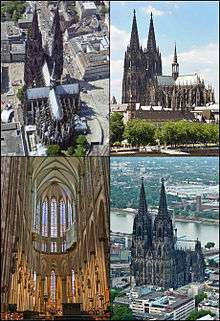 View of Cologne Cathedral across the Rhine | |
| Location | Cologne |
| Country | Germany |
| Denomination | Roman Catholic |
| Architecture | |
| Status | Cathedral |
| Functional status | Active |
| Style | Gothic |
| Years built |
1248-1473 1840s-1880 1950s-2005 (restoration) |
| Specifications | |
| Length | 144.5 metres (474 ft)[1] |
| Width | 86.25 m (283.0 ft)[1] |
| Number of spires | 2 |
| Spire height | 157 m (515 ft)[1] |
| Bells | 12 |
| Administration | |
| Archdiocese | Cologne |
| Province | Cologne |
| Clergy | |
| Provost | Gerd Bachner[2] |
| Vice-provost | Robert Kleine |
| Vicar(s) | Tobias Hopmann[2] |
| Laity | |
| Director of music | Eberhard Metternich |
| Organist(s) | Prof. Dr. Winfried Bönig |
| Building details | |
| Record height | |
| Tallest in the world from 1880 to 1884[I] | |
| Preceded by | Rouen Cathedral |
| Surpassed by | Washington Monument, Ulm Minster |
| Height | |
| Antenna spire | 157.4 m (516 ft) |
| Type | Cultural |
| Criteria | i, ii, iv |
| Designated | 1995 (20th session) |
| Reference no. | 292 |
| Endangered | 2004–2006 |
Cologne Cathedral (German: Kölner Dom, officially Hohe Domkirche Sankt Petrus, Latin: Ecclesia Cathedralis Sanctorum Petri, English: High Cathedral of Saint Peter) is a Roman Catholic cathedral in Cologne, Germany. It is the seat of the Archbishop of Cologne and of the administration of the Archdiocese of Cologne. It is a renowned monument of German Catholicism and Gothic architecture and was declared a World Heritage Site[3] in 1996.[4] It is Germany's most visited landmark, attracting an average of 20,000 people a day[5] and currently the tallest twin-spired church at 157 m (515 ft) tall.
Construction of Cologne Cathedral commenced in 1248 and was halted in 1473, leaving it unfinished. Work restarted in the 19th century and was completed, to the original plan, in 1880.[6] The cathedral is the largest Gothic church in Northern Europe and has the second-tallest spires. The towers for its two huge spires give the cathedral the largest façade of any church in the world. The choir has the largest height to width ratio, 3.6:1, of any medieval church.[7]
Cologne's medieval builders had planned a grand structure to house the reliquary of the Three Kings and fit its role as a place of worship for the Holy Roman Emperor. Despite having been left incomplete during the medieval period, Cologne Cathedral eventually became unified as "a masterpiece of exceptional intrinsic value" and "a powerful testimony to the strength and persistence of Christian belief in medieval and modern Europe".[3]
History

Ancient site
When construction began on the present Cologne Cathedral in 1248, the site had already been occupied by several previous structures. The earliest may have been for grain storage, and possibly was succeeded by a Roman temple built by Mercurius Augustus. From the 4th century on, however, the site was occupied by Christian buildings, including a square edifice known as the "oldest cathedral" that was commissioned by Maternus, the first bishop of Cologne. A free-standing baptistery dating the 6th century was located at the east end of the present cathedral, but was demolished in the 9th century to build the second cathedral. Only ruins of the baptistery and the octagonal baptismal font remain today.[8] The second church, called the "Old Cathedral", was completed in 818. It was destroyed by fire on 30 April 1248, during demolition work to prepare for a new cathedral.
Medieval beginning

In 1164, the Archbishop of Cologne, Rainald of Dassel, acquired the relics of the Three Kings which the Holy Roman Emperor, Frederick Barbarossa, had taken from the Basilica of Sant'Eustorgio, Milan, Italy. (Parts of the relics have since been returned to Milan.) The relics have great religious significance and drew pilgrims from all over Christendom. It was important to church officials that they be properly housed, and thus began a building program in the new style of Gothic architecture, based in particular on the French cathedral of Amiens.
The foundation stone was laid on 15 August 1248, by Archbishop Konrad von Hochstaden. The eastern arm was completed under the direction of Master Gerhard, was consecrated in 1322 and sealed off by a temporary wall so it could be in use as the work proceeded. Eighty four misericords in the choir date from this building phase. In the mid 14th century work on the west front commenced under Master Michael. This work halted in 1473, leaving the south tower complete up to the belfry level and crowned with a huge crane that remained in place as a landmark of the Cologne skyline for 400 years.[9]
Some work proceeded intermittently on the structure of the nave between the west front and the eastern arm, but during the 16th century this ceased.[10]
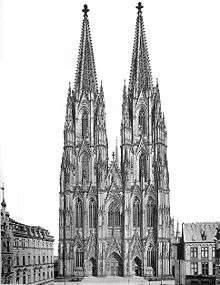
19th century completion
With the 19th century romantic enthusiasm for the Middle Ages, and spurred on by the discovery of the original plan for the façade, it was decided, with the commitment of the Protestant Prussian Court, to complete the cathedral. It was achieved by civic effort; the Central-Dombauverein, founded in 1842, raised two-thirds of the enormous costs, while the Prussian state supplied the remaining third. The state saw this as a way to improve its relations with the large number of Catholic subjects it had gained in 1815.
Work resumed in 1842 to the original design of the surviving medieval plans and drawings, but utilizing more modern construction techniques, including iron roof girders. The nave was completed and the towers were added. The bells were installed in the 1870s. The largest bell is St. Petersglocke.
The completion of Germany's largest cathedral was celebrated as a national event on 14 August 1880, 632 years after construction had begun.[11] The celebration was attended by Emperor Wilhelm I.
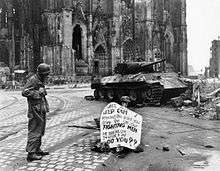
World War II and post-war history
The cathedral suffered fourteen hits by aerial bombs during World War II. Badly damaged, it nevertheless remained standing in an otherwise completely flattened city. The twin spires were an easily recognizable navigational landmark for Allied aircraft bombing.
Repairs were completed in 1956. An emergency repair on the northwest tower's base carried out in 1944 using poor-quality brick taken from a nearby ruined building remained visible until 2005 as a reminder of the war, when it was decided to restore the section to its original appearance. The brick-filling can be seen in the photograph on the right.
Repair and maintenance work is constantly being carried out in one or another section of the building, which is rarely completely free of scaffolding, as wind, rain, and pollution slowly eat away at the stones. The Dombauhütte, established to build the cathedral and keep it in repair, is said to employ the best stonemasons of the Rhineland. There is a common joke in Cologne that the leader of the Dombauhütte, the Dombaumeister (master builder of the cathedral), has to be Roman Catholic and free from giddiness. Half the costs of repair and maintenance are still borne by the Dombauverein.
21st century
On 25 August 2007, the cathedral received a new stained glass window in the south transept. With 113 square metres (1,220 sq ft) of glass, the window was created by the German artist Gerhard Richter. It is composed of 11,500 identically sized pieces of colored glass resembling pixels, randomly arranged by computer, which create a colorful "carpet". Since the loss of the original window in World War II, the space had been temporarily filled with plain glass.[12] The then archbishop of the cathedral, Joachim Cardinal Meisner, who had preferred a figurative depiction of 20th-century Catholic martyrs for the window, did not attend the unveiling.[13] Current holder of the office is Rainer Maria Cardinal Woelki (since 2014). On 5 January 2015, the cathedral remained dark as floodlights were switched off to protest a demonstration by PEGIDA.[14] On 31 December 2015, the Cologne Cathedral was near the site of mass sex attacks during New Year's Eve celebrations.[15]
World Heritage Site
In 1996, the cathedral was added to the UNESCO World Heritage List of culturally important sites. In 2004 it was placed on the "World Heritage in Danger" list, as the only Western site in danger, due to plans to construct a high-rise building nearby, which would have visually impacted the site. The cathedral was removed from the List of In Danger Sites in 2006, following the authorities' decision to limit the heights of buildings constructed near and around the cathedral.
As a World Heritage Site, and with its convenient position on tourist routes, Cologne Cathedral is a major tourist attraction, the visitors including many who travel there as a Christian pilgrimage.
Visitors can climb 509 stone steps of the spiral staircase to a viewing platform about 98 m (322 ft) above the ground. The platform gives a scenic view over the Rhine.
On 18 August 2005, Pope Benedict XVI visited the cathedral during his apostolic visit to Germany, as part of World Youth Day 2005 festivities. An estimated one million pilgrims visited the cathedral during this time. Also as part of the events of World Youth Day, Cologne Cathedral hosted a televised gala performance of Beethoven's Missa Solemnis, performed by the Royal Philharmonic Orchestra and the London Philharmonic Choir conducted by Sir Gilbert Levine.
Architecture
The design of Cologne Cathedral was based quite closely on that of Amiens Cathedral in terms of ground plan, style and the width to height proportion of the central nave. The plan is in the shape of a Latin Cross, as is usual with Gothic cathedrals. It has two aisles on either side, which help to support one of the very highest Gothic vaults in the world, being nearly as tall as that of the Beauvais Cathedral, much of which collapsed. Externally the outward thrust of the vault is taken up by flying buttresses in the French manner. The eastern end has a single ambulatory, the second aisle resolving into a chevet of seven radiating chapels.
Internally, the medieval choir is more varied and less mechanical in its details than the 19th century building. It presents a French style arrangement of very tall arcade, a delicate narrow triforium gallery lit by windows and with detailed tracery merging with that of the windows above. The clerestory windows are tall and retain some old figurative glass in the lower sections. The whole is united by the tall shafts that sweep unbroken from the floor to their capitals at the spring of the vault. The vault is of plain quadripartite arrangement.
The choir retains a great many of its original fittings, including the carved stalls, which is made the more surprising by the fact that French Revolutionary troops had desecrated the building. A large stone statue of St Christopher looks down towards the place where the earlier entrance to the cathedral was, before its completion in the late 19th century.
The nave has many 19th century stained glass windows. A set of five on the south side is called the Bayernfenster, and were a gift from Ludwig I of Bavaria, and strongly represent the painterly German style of that date.
Externally, particularly from a distance, the building is dominated by its huge spires, which are entirely Germanic in character, being openwork like those of Ulm, Vienna, Strasbourg and Regensburg Cathedrals.[16]
- A "Bird's eye view" shows the cruciform plan
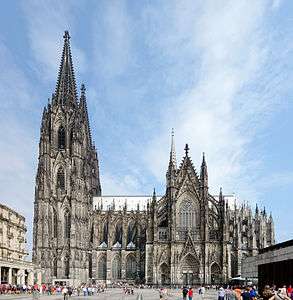 The cathedral from the south
The cathedral from the south The exterior of one of the spires
The exterior of one of the spires The main entrance shows the 19th century decoration.
The main entrance shows the 19th century decoration.
.jpg) "Bird's eye view" from the east
"Bird's eye view" from the east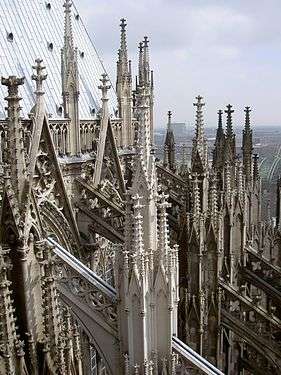 The flying buttresses and pinnacles of the Medieval east end.
The flying buttresses and pinnacles of the Medieval east end.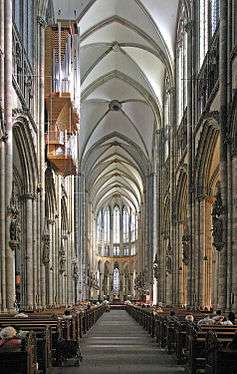 The nave looking east
The nave looking east- Interior of the Medieval east end, showing the extreme height.
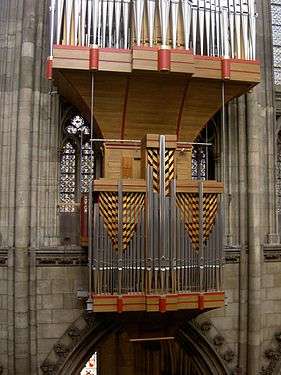 This "swallows' nest" organ was built into the gallery in 1998, to celebrate the cathedral's 750 years.
This "swallows' nest" organ was built into the gallery in 1998, to celebrate the cathedral's 750 years.
Dimensions
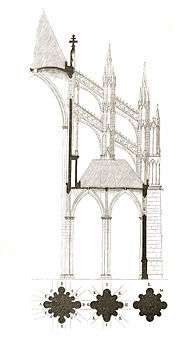
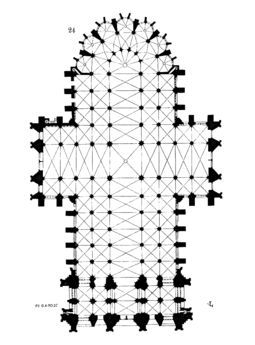
| External length | 144.58 m (474.3 ft) |
| External width | 86.25 m (283.0 ft) |
| Width of west façade | 61.54 m (201.9 ft) |
| Width of transept façade | 39.95 m (131.1 ft) |
| Width of nave (with aisles, interior) | 45.19 m (148.3 ft) |
| Height of southern tower | 157.31 m (516.1 ft) |
| Height of northern tower | 157.38 m (516.3 ft) |
| Height of ridge turret | 109.00 m (357.61 ft) |
| Height of transept façades | 69.95 m (229.5 ft) |
| Height of roof ridge | 61.10 m (200.5 ft) |
| Inner height of nave | 43.35 m (142.2 ft) |
| Building area | 7,914 m2 (85,185.59 sq ft) |
| Window surface area | 10,000 m2 (107,639.10 sq ft) |
| Roof surface area | 12,000 m2 (129,166.93 sq ft) |
| Gross volume without buttresses | 407,000 m3 (14,400,000 cu ft) |
Treasures
One of the treasures of the cathedral is the High Altar, which was installed in 1322. It is constructed of black marble, with a solid slab 15 feet (4.6 m) long forming the top. The front and sides are overlaid with white marble niches into which are set figures, with the Coronation of the Virgin at the centre.[17]
The most celebrated work of art in the cathedral is the Shrine of the Three Kings, commissioned by Philip von Heinsberg, archbishop of Cologne from 1167 to 1191 and created by Nicholas of Verdun, began in 1190. It is traditionally believed to hold the remains of the Three Wise Men, whose relics were acquired by Frederick Barbarossa at the conquest of Milan in 1164. The shrine takes the form a large reliquary in the shape of a basilican church, made of bronze and silver, gilded and ornamented with architectonic details, figurative sculpture, enamels and gemstones. The shrine was opened in 1864 and was found to contain bones and garments.
Near the sacristy is the Gero-Kreuz,[18] a large crucifix carved in oak and with traces of paint and gilding. Believed to have been commissioned around 960 for Archbishop Gero, it is the oldest large crucifix north of the Alps and the earliest-known large free-standing Northern sculpture of the medieval period.[19]
In the Sacrament Chapel is the Mailänder Madonna ("Milan Madonna"), dating from around 1290, a wooden sculpture depicting the Blessed Virgin Mary and the infant Jesus. The altar of the patron saints of Cologne with an altar piece by the International Gothic painter Stefan Lochner is in the Marienkapelle ("St. Mary's Chapel"). Other works of art are in the Cathedral Treasury. The altar also houses the relics of Saint Irmgardis.
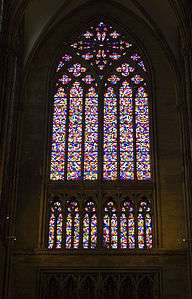 Modern stained glass window by Gerhard Richter.
Modern stained glass window by Gerhard Richter..jpg) The Medieval statue of St. Christopher welcomes travellers
The Medieval statue of St. Christopher welcomes travellers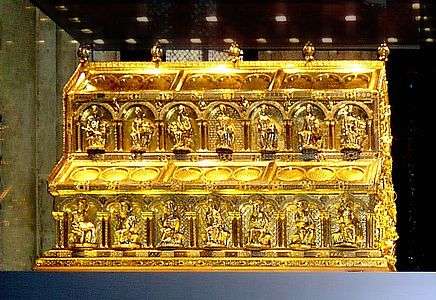
.jpg) Anbetungs-Fenster, 1846.
Anbetungs-Fenster, 1846. The Crucifix of Bishop Gero, 10th century, the oldest known large crucifix
The Crucifix of Bishop Gero, 10th century, the oldest known large crucifix.jpg) Petrus- und Wurzel Jesse-Fenster, 1509.
Petrus- und Wurzel Jesse-Fenster, 1509.
Jewish tablets
Embedded in the interior wall are a pair of stone tablets on which are carved the provisions formulated by Archbishop Englebert II (1262–67) under which Jews were permitted to reside in Cologne.[20]
Church music
Cologne Cathedral has two pipe organs by Klais Orgelbau, the Transept Organ built in 1948 and the Nave Organ built in 1998. Cathedral organists have included Josef Zimmermann, Clemens Ganz (1985–2001) and Winfried Bönig (2001).
Bells
The cathedral has eleven church bells, four of which are medieval. The first was the 3.8-ton Dreikönigsglocke ("Bell of the Three Kings"), cast in 1418, installed in 1437, and recast in 1880. Two of the other bells, the Pretiosa (10.5 tons; at that time the largest bell in the Western world) and the Speciosa (5.6 tons) were installed in 1448 and remain in place today.
During the 19th century, as the building neared completion, there was a desire to extend the number of bells. This was facilitated by Kaiser Wilhelm I who gave French bronze cannon, captured in 1870–71, for this purpose. The 22 pieces of artillery were displayed outside the Cathedral on 11 May 1872. Andreas Hamm in Frankenthal used them to cast a bell of over 27,000 kilos on 19 August 1873. The tone was not harmonious and another attempt was made on 13 November 1873. The Central Cathedral Association, which had agreed to take over the costs, did not want this bell either. Another attempt took place on 3 October 1874. The colossal bell was shipped to Cologne and on 13 May 1875, installed in the Cathedral. This Kaiserglocke was eventually dismantled in 1918 to support the German war effort.
The 24-ton St. Petersglocke ("Bell of St. Peter", "Decke Pitter" in the Kölsch language), was cast in 1922 and is the largest free-swinging bell in the world.[21]
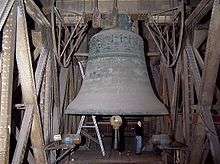
Bells of the ridge turret:
- Vespers Bell (Mettglocke) 0.280 tons
- Consecration Bell (Wandlungsglocke) 0.425 tons
- Angelus Bell (Angelusglocke) 0.763 tons
Bells of the main bell cage in the south spire:
- Hail Bell (Aveglocke) 0.830 tons
- Chapter Bell (Kapitelsglocke) 1.400 tons
- St Joseph's Bell (Josephglocke) 2.200 tons
- St Ursula's Bell (Ursulaglocke) 2.550 tons
- Bell of the Three Kings (Dreikönigsglocke) 3.800 tons
- Speciosa 5.600 tons
- Pretiosa 10.500 tons
- St Peter's Bell (St. Petersglocke, Great bell of Germany) 24.000 ton
See also
- Architecture of cathedrals and great churches
- Gero Cross
- Gothic architecture
- Gothic Revival architecture
- List of buildings and structures
- List of highest church naves
- Medievalism
References
- 1 2 3 "Cologne Cathedral official website". Koelner-dom.de. Retrieved 15 August 2010.
- 1 2 "Domkapitel".
- 1 2 "UNESCO World Heritage Sites, Cologne Cathedral". Whc.unesco.org. Retrieved 15 August 2010.
- ↑ "Cologne Cathedral". www.cologne-tourism.com. Retrieved 2016-02-11.
- ↑ A Little Closer to Heaven, the official movie, Cologne Cathedral website. Retrieved 7 November 2010.
- ↑ Centre, UNESCO World Heritage. "Cologne Cathedral - UNESCO World Heritage Centre". whc.unesco.org. Retrieved 2016-02-11.
- ↑ Fletcher, Banister (1905). A History of Architecture on the Comparative Method. Scribner's Sons.
- ↑ Baptismal font behind cathedral
- ↑ Wim Swaan
- ↑ Wim Swaan gives the latest date as 1560, but a date of 1520 is considered more probable by other scholars.
- ↑ Fallows, Samuel, ed. (1895). Progress. The University Association. p. 468. Retrieved 13 August 2011.
- ↑ "Google Translate".
- ↑ Fortini, Amanda (9 December 2007). "Pixelated Stained Glass". The New York Times. ISSN 0362-4331. Retrieved 12 January 2008.
- ↑ "Germany Pegida protests: Rallies over 'Islamisation'". BBC. 6 January 2015. Retrieved 7 January 2015.
In Cologne, the authorities switched off the lights of the city's cathedral as a way of warning Pegida supporters they were supporting "extremists". "We don't think of it as a protest, but we would like to make the many conservative Christians [who support Pegida] think about what they are doing," the dean of the cathedral, Norbert Feldhoff, told the BBC.
- ↑ "Germany shocked by Cologne New Year gang assaults on women". Retrieved 5 January 2016.
- ↑ Wim Swaan, Banister Fletcher
- ↑ Joan Holladay, Iconography of the High Altar in Cologne Cathedral, (1989)
- ↑ Arthistory, University of Pennsylvania
- ↑ Howard Hibbard
- ↑ A social and religious history of the Jews, Salo Wittmayer Baron, 2nd Edition, Columbia University Press, 1965, p. 174
- ↑ The World Peace Bell in Newport, Kentucky is larger, but turns around its center of mass rather than its top.
Sources
- Wim Swaan, The Gothic Cathedral, Omega Books (1969), ISBN 0-907853-48-X
- Banister Fletcher, A History of Architecture on the Comparative Method.
- Howard Hubbard, Masterpieces of Western Sculpture, Thames and Hudson, ISBN 0-500-23278-4
- Wolff, Arnold, Cologne Cathedral. Its History – Its Works of Arts, Verlag (editor) Kölner Dom, Cologne: 2nd edition 2003, ISBN 978-3-7743-0342-3
External links
| Wikimedia Commons has media related to Cologne Cathedral. |
- Cologne Cathedral Official website (German) (Spanish) (French) (Polish) (English)
- unesco World Heritage Sites, Cologne Cathedral
- Web cam showing Cologne Cathedral (German)
- Cologne Cathedral at Structurae
- 5 Gigapixels GigaPan of Cologne Cathedral
| Records | ||
|---|---|---|
| Preceded by Rouen Cathedral |
World's tallest structure 1880–1884 157.38 m |
Succeeded by Washington Monument |
| Tallest building in the world 1880–1890 157.38 m |
Succeeded by Ulm Minster | |
| Tallest building in Europe 1880–1890 157.38 m | ||